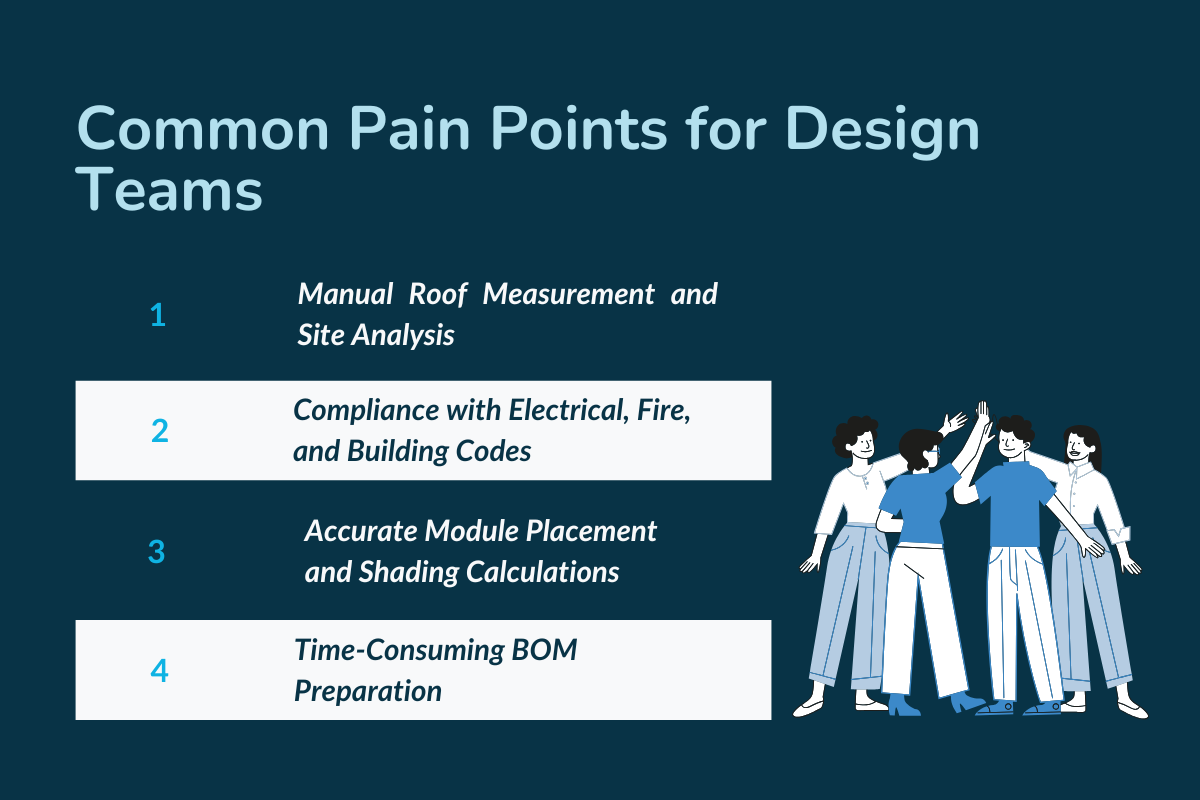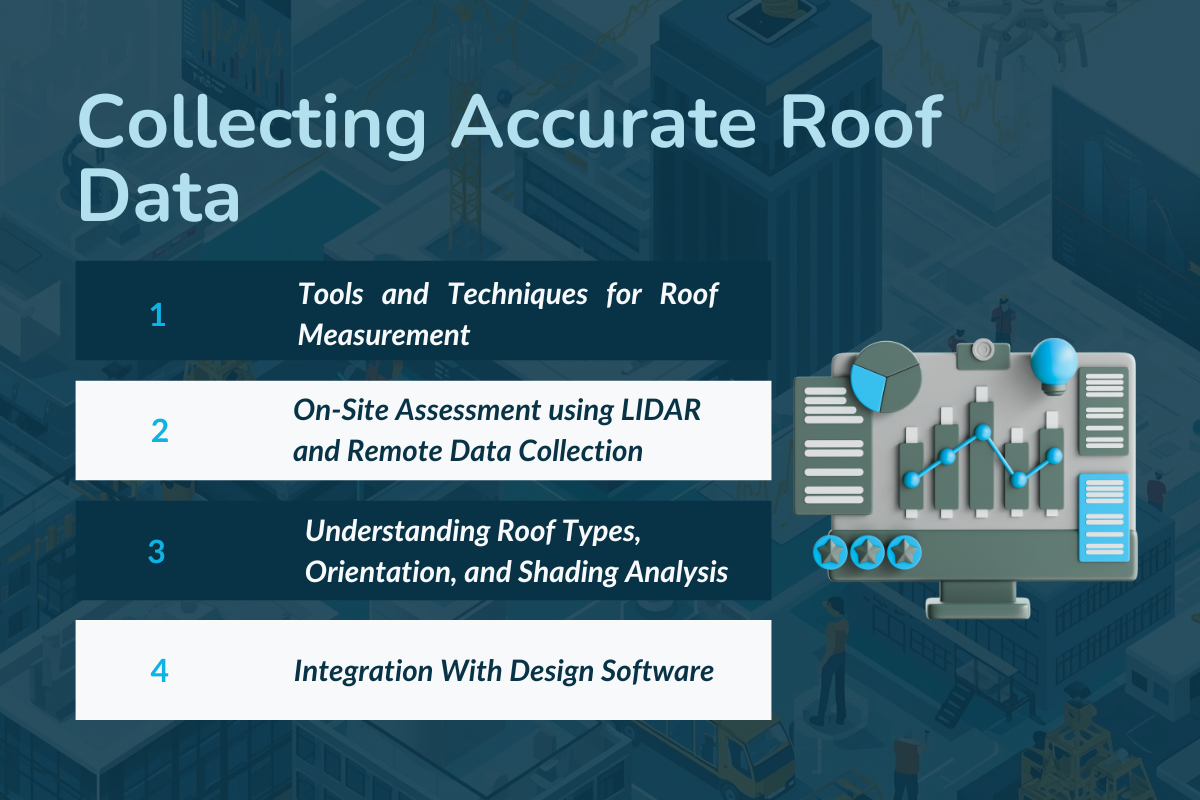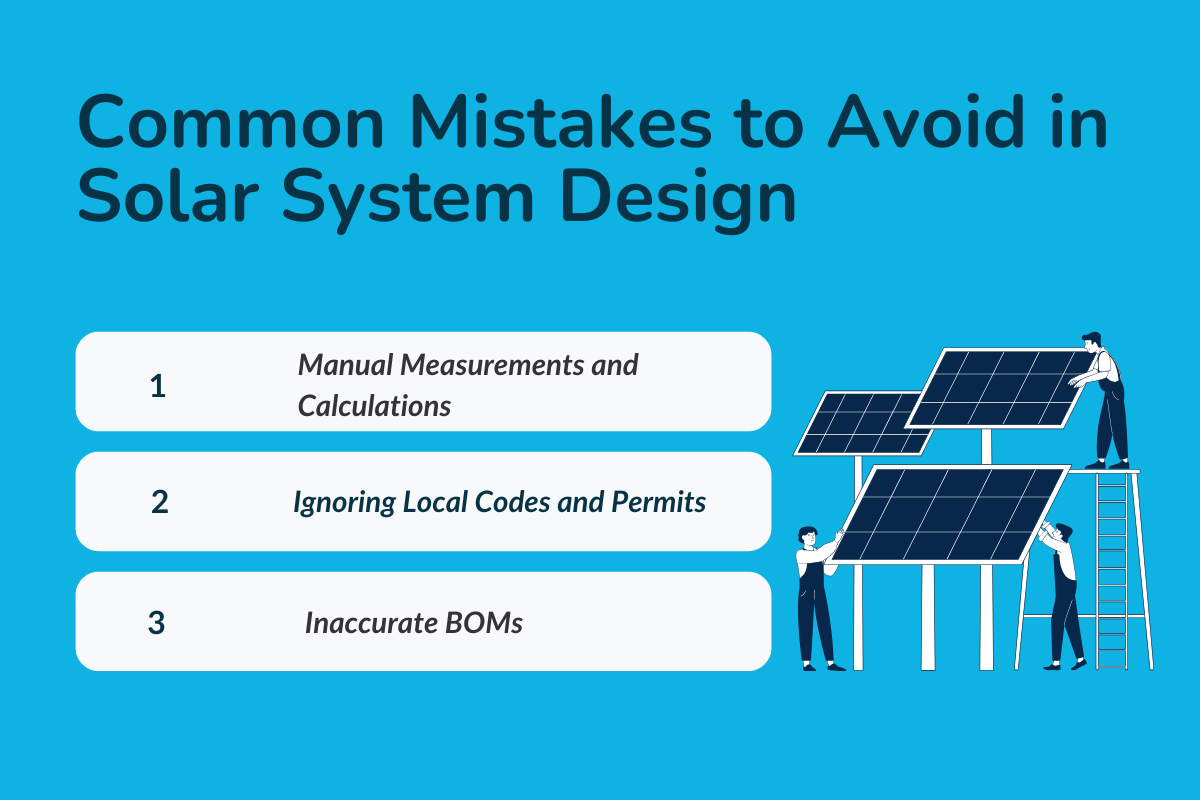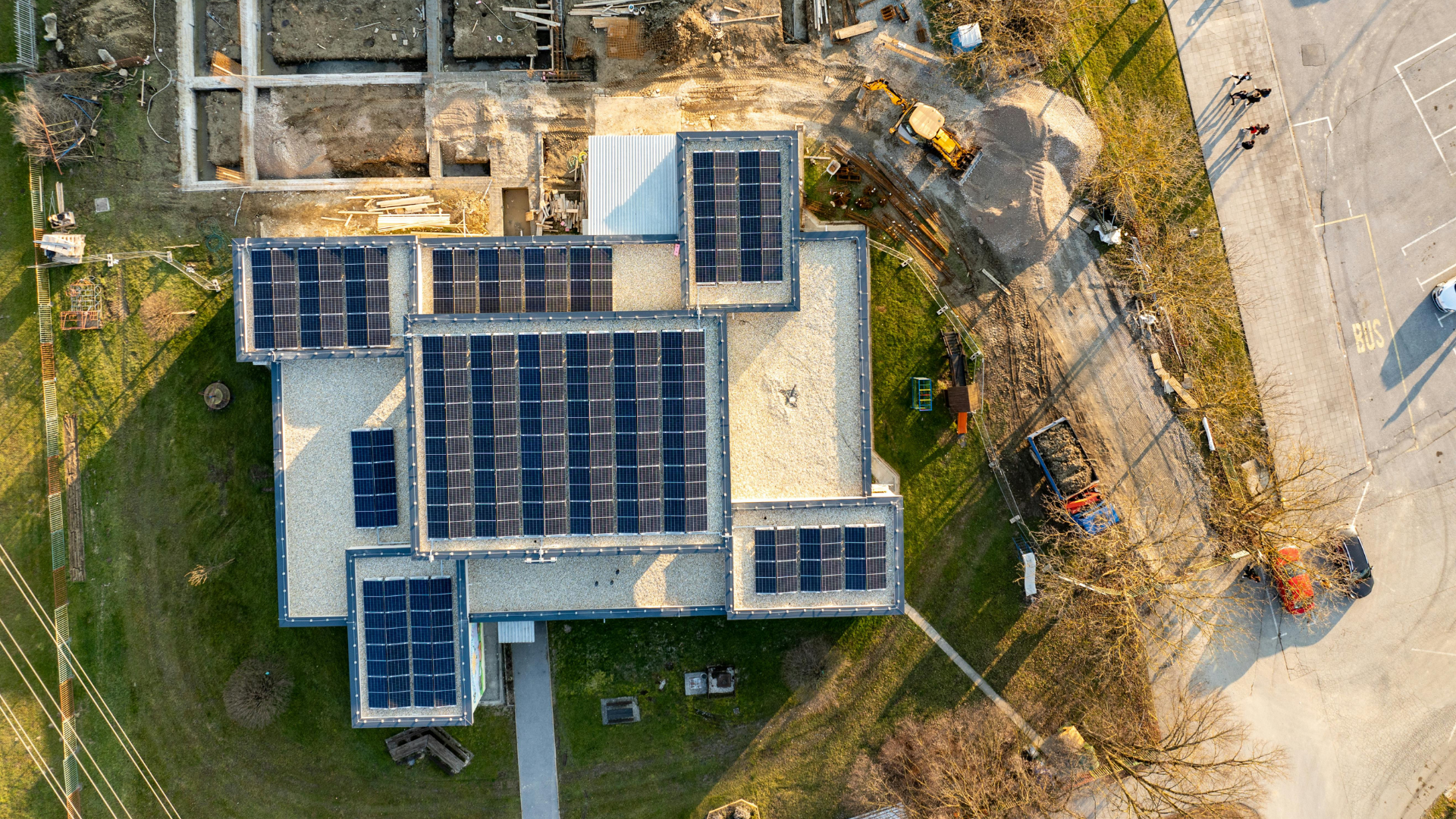November 18, 2025
Audio overview: Listen & Learn
How many hours does your solar design team lose on tasks that could be automated? If you're still relying on manual roof measurements, tedious layout drafting, and double-checking local codes, you're losing valuable time and money.
This old process is a major bottleneck, creating errors in your plans and Bill of Materials that slow down your entire sales cycle and eat into your profits.
There is a faster, more accurate way to operate. This master guide explores the modern, data-driven workflow for solar system design.
We'll show you how to move from initial roof data to a code-compliant plan and a perfect BOM in a fraction of the time, empowering your business to reduce costs and sell more solar.
The Complete Guide to Solar System Design: Reduce Costs and Boost Sales with Automation
Relying on manual solar system design is a critical drag on your business, leading to slow turnarounds and lost revenue.
This guide delivers the blueprint to leverage the tools, helping you reduce costs, supercharge your sales process, and build a more profitable solar company.
Key Takeaways
- Manual design is slowing your growth: Relying on outdated tools for roof measurement, layout drafting, and BOM creation leads to errors, delays, and lost revenue.
- Automation is the new standard: Modern solar design software automates roof data capture, ensures NEC code compliance, and generates accurate BOMs in minutes.
- Data-driven workflows increase accuracy: Automated design tools integrate LIDAR data, electrical codes, and component libraries to produce precise, permit-ready plans.
- Sunbase simplifies it all: From roof data to code-compliant layouts and real-time collaboration, Sunbase automates every step of the solar design process, empowering teams to scale faster and smarter.
Ready to Design Smarter Solar Systems?
Streamline your workflow with Sunbase — automate everything from accurate roof data collection to code-compliant designs and BOM generation. Get Started with Sunbase Now!
Why Solar System Design Is More Complex Than It Seems
At first glance, designing a solar PV system might look like just placing rectangles on a roof. But for professional installers, it’s a complex puzzle involving architectural constraints, electrical engineering, strict legal codes, and financial optimization. Getting it wrong is not an option.
Common Pain Points for Design Teams

Every experienced design team has faced these frustrating and time-consuming challenges:
1. Manual Roof Measurement and Site Analysis: Sending a team to a customer’s house with a tape measure is slow, prone to human error, and introduces safety risks. A single incorrect measurement can derail the entire plan.
2. Compliance with Electrical, Fire, and Building Codes: Navigating the maze of the National Electrical Code (NEC), local fire setbacks, and municipal building codes is a monumental task. These codes are constantly updated and vary by jurisdiction, making compliance a moving target.
3. Accurate Module Placement and Shading Calculations: Every vent, chimney, and nearby tree casts a shadow that can significantly impact the energy output of your solar system. Manually calculating this impact throughout the day and year is incredibly complex and often inaccurate.
4. Time-Consuming BOM Preparation: Manually creating a Bill of Materials (BOM) is a tedious process. Forgetting a single inverter, a specific type of racking, or the right number of connectors can halt an installation and lead to last-minute scrambles.
The Cost of Errors in Design
Small mistakes in the design phase cascade into expensive problems down the line. These mistakes cost:
- Rework and Delays: An inaccurate design often doesn't get discovered until the installation crew is on the roof. This leads to costly on-site changes, project delays, and frustrated customers. Permitting issues alone can add weeks or even months to a project timeline.
- Increased Material Costs due to Inaccurate BOM: An incorrect BOM can lead to over-ordering materials (wasting money) or under-ordering (causing expensive, expedited shipping and work stoppages).
- Permitting Issues and Failed Inspections: Local authorities (AHJs) will reject plans that don't meet their specific requirements.
- According to NREL, permitting, inspection, and intersection(PII) costs are a major part of the total capital cost. Failed inspections mean more delays and fees, directly eating into your profit margins.
Step-by-Step Guide to Solar System Design and Planning
To build a scalable solar business, you need a process that is repeatable, accurate, and efficient. Let’s break down the modern workflow for flawless solar system design.
Step 1 – Collecting Accurate Roof Data

Everything begins with a perfect digital twin, represented by data from the project site. Bad data in means bad design out, and no solar development due to high energy consumption.
Tools and Techniques for Roof Measurement
The days of climbing on every roof are over. Today’s solar companies use a variety of technologies to get precise measurements remotely.
On-Site Assessment using LIDAR and Remote Data Collection
Forget climbing on roofs. Today's design starts with accurate data, collected remotely. The old way of sending someone out to measure a roof takes hours and leads to mistakes.
Advanced software now uses satellite images and LIDAR (a laser scanning technology) to create a perfect 3D model of the roof and yard in minutes. This gives you exact measurements, roof angles, and precise shadow mapping.
As a result, you can get a shading report in under 15 minutes, which is about 85% faster than before, with accuracy within about 3.5% of an on-site check (EasySolar).
This small table shows how the manual process compares to an automated one:
| Design Phase | Manual Process | Automated/LIDAR Process | Time Savings (Approx.) |
|---|---|---|---|
| Site Assessment | On-site visit, manual shade study. (2–3 hours) | Remote One-Click Site Evaluation with LIDAR. (15–20 minutes) | ∼85% |
Understanding Roof Types, Orientation, and Shading Analysis
Once you have the model, you need to understand the canvas you’re working on.
- Flat vs. Pitched Roofs: Pitched roofs are common for residential homes, while flat roofs are typical for commercial buildings. Each requires different racking solutions, ballast considerations, and layout strategies.
- Azimuth, Tilt, and Shading Analysis: For optimal power generation in the Northern Hemisphere, solar panels should ideally face south.
- The azimuth (the compass direction) and tilt (the angle) of the roof are critical variables. A thorough shading analysis is essential to identify how trees and obstructions will affect energy production.
- Common Challenges with Complex Roof Geometries: Hips, gables, dormers, and multiple roof facets complicate a layout. Automated design tools excel in this area, as they can instantly map these obstructions and optimize the panel layout around them.
Integration With Design Software
The true power of remote data collection is realized when it integrates seamlessly with your design platform. Importing precise roof data automatically eliminates the risk of manual data entry errors and serves as the foundation for a reliable solar project plan.
Step 2 – Designing a Compliant Solar Panel System
With an accurate site model, you can begin the engineering phase. This is where you balance energy production, safety, battery capacity, and regulatory compliance.
Electrical and Structural Considerations
- Load Calculations: You must ensure the existing electrical service can handle the addition of a solar PV system.
- String Sizing and Inverter Selection: This is a crucial step. You need to calculate the optimal number of solar panels (modules) per string to match the inverter’s voltage and current specifications. Improper string sizing can lead to poor performance or even damage the equipment.
- Roof Weight Limits and Structural Integrity Checks: Solar panels and racking add weight to a roof. The design must account for this additional load, plus potential snow and wind loads, to ensure the structure remains sound.
Code Compliance Made Simple
Navigating regulations is one of the most significant soft costs.
- NEC and Local Regulations: The National Electrical Code (NEC) provides the baseline for safe solar installations in the U.S. Key articles, such as NEC 690 (Solar Photovoltaic Systems) and NEC 705 (Interconnected Electric Power Production Sources), govern everything from wiring to grounding. Automated design software often has these rule sets built in.
- Fire Setbacks and Panel Spacing: Fire codes mandate clear pathways on the roof for firefighter access. These setback rules dictate how close your panels can be to hips, ridges, and eaves.
- Documentation for Permitting: A permit package is more than just a drawing. It includes single-line diagrams, site plans, spec sheets for all components, and structural calculations. Modern tools can auto-generate these comprehensive plan sets, ready for submission.
Optimizing Layout for Performance
The ultimate goal is to generate the maximum amount of electricity possible.
- Module Placement Strategies: Place panels on the sunniest roof facets, avoiding shade from vents, chimneys, and trees.
- Minimizing Shading and Maximizing Energy Yield: Use the shading analysis data to ensure panels are not placed in areas that will be shaded during peak sun hours. Even small amounts of shade can significantly reduce the output of an entire string of panels.
- Balancing Aesthetics and Functionality: For homeowners, the appearance of the solar system is important. A good design creates a clean, symmetrical look that complements the house while maximizing energy production.
Step 3 – Automating BOM Preparation for PV Systems
An accurate design is useless if you don’t have the right parts to build it.
Why BOM Accuracy Matters

The Bill of Materials is the link between your design and the physical installation.
- Cost Estimation and Procurement Planning: A precise BOM ensures your financial models are accurate and that your procurement team orders the right components.
- Avoiding Delays Caused by Missing Materials: There’s nothing worse than having an installation crew on-site, ready to work, only to find out you’re missing a specific type of clamp or connector. This stops the project cold.
- Reducing On-site Adjustments: When the BOM is perfect, the installers can work efficiently without having to improvise or make last-minute changes.
Tool for Automated BOM Generation
This is where automation truly shines. Modern solar software links every design element directly to a component library.
When you place a solar panel on the roof in the design, the platform automatically adds the panel, the racking, the microinverter/optimizer, and all associated hardware to the BOM in real time. If you change the inverter or add more modules, the BOM updates instantly, eliminating human error.
Also read: Sunbase Integrates with IronRidge: Instantly Calculate Solar Racking Materials.
Step 4 – Streamlining Collaboration and Workflow to Win More Deals
A solar project involves multiple teams: sales, engineering, procurement, and installation. Keeping everyone on the same page is critical.
Centralized Design Platforms and Automated Design
Using a centralized, cloud-based platform, such as Sunbase, means everyone is working from the same set of plans. The sales team can see the latest design revision, the procurement team can see the final BOM, and the installers can pull up the approved plans on a tablet from the job site.
This eliminates version control issues and ensures seamless communication.
Step 5 – Leveraging Data-Driven Insights
Great design doesn’t stop when the plan is approved. It creates a feedback loop for continuous improvement.
Performance Simulation and Forecasting
Before the install, you need to provide the customer with an accurate forecast of how much energy their system will produce.
Modern software uses the 3D model, shading data, local weather history, and specific component efficiencies to run sophisticated simulations, predicting annual output with a high degree of accuracy. This builds trust with customers and helps your sales team sell more effectively.
Workflow Gains: Quantifying Automation's Efficiency and Value
The transition from a manual to an automated design process yields significant efficiency gains that directly impact project timeliness and the bottom line.
| Metric | Manual Process | Automated Process | Improvement |
|---|---|---|---|
| Site Assessment | Hours to Days | 15–20 Minutes | ∼85% Faster |
| Layout Design | 4–6 Hours | 30–45 Minutes | ∼87% Faster |
| Proposal Creation | 3–4 Hours | 10–15 Minutes | ∼93% Faster |
| Productivity | Low Volume/High Labor | High Volume/Low Labor | Sales reps ∼are 7× more efficient |
Tools That Make Solar System Design Efficient
To implement this modern workflow, you need the right tools. An all-in-one platform is the key to unlocking maximum efficiency.
Meet Sunbase Solar Software
For professional teams seeking a single, scalable solution, platforms like Sunbase integrate all necessary functions into one seamless workflow. Sunbase is an all-in-one platform that combines solar design, CRM, proposal generation, and project management.
- Automated roof data capture and measurement
- Code-compliant system design templates
- Auto-generated BOMs and procurement-ready reports
- Performance simulation dashboards
This integrated approach eliminates tool switching, boosts design accuracy, and accelerates the sales process, supporting solar companies that are looking to scale their business and improve close rates.
Common Mistakes to Avoid in Solar System Design

By embracing automation, you can avoid the most common and costly pitfalls:
1. Manual Measurements and Calculations: This is the #1 source of preventable errors. Trusting technology for site analysis eliminates the risk of human error and saves hours of labor.
2. Ignoring Local Codes and Permits: Don't treat code compliance as an afterthought. Using software with built-in compliance engines ensures your designs are right the first time, preventing rejections that cause massive delays.
3. Inaccurate BOMs: A design is only as good as its parts list. Automated BOM generation is not a luxury; it's a necessity for controlling costs and keeping projects on schedule.
By moving from a fragmented, manual process to an integrated, automated workflow, you can build a more resilient, profitable, and scalable solar business.
Summing It Up
The future of the solar industry isn't about working harder, but smarter.
By replacing manual, error-prone solar system design with an automated, data-driven workflow, your company can eliminate critical bottlenecks and streamline operations. This shift dramatically cuts design time, ensures BOM accuracy, and simplifies code compliance.
The result is a faster sales process, lower operational costs, and a powerful competitive edge, empowering your business to install more solar and accelerate growth in a competitive market.
About Sunbase
Sunbase is the all-in-one platform that streamlines your entire workflow, from automated solar design and CRM to professional proposal generation. Stop juggling multiple tools and start empowering your sales team to reduce costs and close deals faster.
Ready to see how much time you can save? Schedule a demo today!
Frequently Asked Questions (FAQs)
How to design your own solar system?
First, calculate your home's energy needs to size the system.1 Then, select panels, an inverter, and create a code-compliant layout.
What is the 120 rule for solar panels?
It's a design guideline that ensures a solar panel string's maximum open-circuit voltage (Voc) remains safely below the inverter's input voltage limit.
What is the 33% rule in solar panels?
A rule of thumb for string inverters suggests that the operating voltage should be 33% above the inverter’s minimum MPPT voltage for efficiency.
How big of a solar system do you need to power a house?
This depends on your annual energy use (kWh) and location. The average home typically requires a system between 5 to 12 kW.
I agree to receive marketing messaging from Sunbase at the phone number provided above. I understand data rates will apply, and can reply STOP to OPT OUT.







